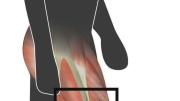Today’s state-of-the-art prosthetic limbs are scientific marvels, designed with robotics and sensors that respond to neural and muscular signals, to give users the possibility of greater function and control.
But amputation techniques lag far behind these sophisticated prostheses. “The amputation paradigm hasn’t significantly changed in the last 200 years,” explains Shriya Srinivasan, a doctoral student in the Harvard-MIT Health Sciences and Technology (HST) program. In typical amputations, nerves and muscles are cut and arranged somewhat haphazardly; the main goal is to create a sturdy, well-padded appendage. “The types of neural signals and muscles signals that you get are really unstable. They decrease over time, and sometimes researchers can’t isolate individual muscles,” Srinivasan says, calling this “a mismatch between the technology and the human physiology.”

Shriya Srinivasan
Photograph courtesy of Shriya Srinivasan
Working on a team that included Matthew J. Carty ’95, associate professor of surgery at Harvard Medical School (HMS) and a reconstructive plastic surgeon at Brigham and Women’s Hospital, and Hugh Herr, her adviser, who heads the biomechatronics lab at MIT, Srinivasan helped develop a new process for performing amputations. It ensures better communication between the body and prosthesis, with the goal of giving the patient more natural sensation and movement.
This approach, known as the agonist-antagonist myoneural interface (AMI), uses muscle grafts from the patient’s body and existing nerves at the amputation site to create muscle pairs that mimic those found in uninjured limbs. Ordinarily, when one muscle contracts, the opposing muscle stretches, actions that provide key sensory feedback—proprioception—about the location of the body. Thus someone with a normally functioning foot stepping off a curb knows “where that foot is in space and is able to adjust to the change in height automatically,” Srinivasan says, intuitively sensing the speed of movement and amount of force required. “A person without any of that sensory feedback has to watch the ankle or leg as it moves off the curb and onto the street,” and then calculate how to place the body. (Some people with lower-limb amputations describe a “ski boot” sensation, in which their ankle joint feels locked and unable to move.)
Srinivasan and her colleagues tested the AMI surgical process in rats (research they describe in Science Robotics), and confirmed that they could successfully create these dynamic muscle pairs. Nerve tissue in the muscles regenerated quickly, allowing the muscles to communicate with the brain. The researchers expect similar results in humans. They are just beginning to perform the AMI surgery on human candidates; Hugh Herr himself, a double amputee who earned his Harvard doctorate in biophysics in 1998, plans to undergo it. The researchers say the procedure will work both in new amputations and in cases where the initial surgery occurred many years ago. As an additional benefit, AMI may solve the problem of neuromas, common in normal amputation, in which severed nerves become painfully hypersensitive when embedded in muscle tissue. “We give the transected nerves a home to live in, and they grow back into the muscles,” Srinivasan explains. “We don’t see the same unhealthy nervous tissue formation that normally occurs.”
To develop AMI, the researchers drew insights from a multidisciplinary approach historically missing in amputation and the prosthetics field. “There’s been a lack of communication among surgeons, researchers, prosthetists, and the people who are actually designing the robots used in prosthetics,” Srinivasan says. By using a systems perspective, Carty reports, “We’ve been able to have discussions that yield solutions that I think none of us could have come up with on our own as effectively or as gracefully.”
Srinivasan says the HST program has been ideal because it has allowed her to combine her work in MIT’s biomechatronics lab with clinical courses and HMS rotations that have deepened her understanding of human physiology. She has long considered the challenges of moving with a prosthetic limb; she is co-founder of Anubhava Dance Company, a professional group of classical Indian dancers from around North America who gather frequently to perform. One of her fellow dancers, a close friend from childhood, uses a leg prosthesis. “When you’re dancing, it’s all about having your mind in tune with the rest of your body, and being able to feel your arms and legs in space,” she says. “I’m hopeful that we’ve found a more elegant solution for people like my friend, who could have a much greater sense of functionality.”
Carty foresees a day when AMI is the standard approach for amputations. “This technique could allow patients who’ve undergone limb loss to recapture a degree of ‘wholeness’ that is usually lost forever for amputees,” he says. “This represents a way to get at least some of that—and maybe a lot of that—back.”









